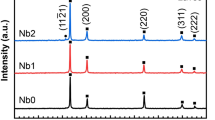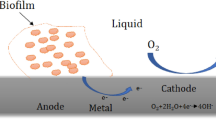Abstract
The studies on corrosion control of 6061Al–15%(V) SiC(P) composite (AlMMCs) in 0.025 M HCl have been carried out by employing electrochemical techniques like potentiodynamic polarization (PDP) and electrochemical impedance spectroscopy (EIS) using biopolymer pectin as inhibitor. Pectin showed increase in the inhibition efficiency, when the concentration of it was increased from 0.2 to 1.0 g L−1. Inhibition efficiency also increased with increasing the temperature of corrosive medium from 303 to 323 K. The thermodynamic and kinetic calculations showed that pectin underwent chemisorption by following Langmuir adsorption isotherm. Surface morphology studies were carried using scanning electron microscopy (SEM), and it was supported by elemental analysis performed by using energy-dispersive x-ray (EDX) analysis technique. Suitable mechanism was proposed for the corrosion inhibition process. Maximum inhibition efficiency of 95% was observed for the addition of 1 g L−1 of pectin. Pectin emerged as an excellent green corrosion inhibitor for the corrosion control of AlMMCs in acid medium, with environment benefits.












Similar content being viewed by others
References
G.Y. Elewady, I.A. El-Said, A.S. Fouda, Anion surfactants as corrosion inhibitors for aluminum dissolution in hcl solutions. Int. J. Electrochem. Sci. 3, 177–190 (2008)
J.R. Davis, Aluminum and Aluminum alloys, ASM International Publishers, ch. 1, 212
J.G. Kaufman, Introduction to aluminum alloys and tempers, ASM International Publishers, ch.3, 324
Y. Lakhtin, Engineering Physical Metallurgy, New Delhi: CBS Publishers & Distributors, ch.17, 1998
S. Prabu, L. Karunamoorthy, S. Kathiresan, B. Mohan, Influence of Stirring Speed and Stirring Time on Distribution of Particles in Cast Metal Matrix Composite. J. Mater. Process. Technol. 171(20), 268–273 (2006)
B. Bobic, S. Mitrovic, M. Babic, I. Bobic, Corrosion of metal-matrix composites with aluminium alloy substrate. Tribol Ind 32, 3–15 (2010)
S. Avner, Introduction to Physical Metallurgy, 2nd edn. (Tata McGraw-Hill, New Delhi, 1997), pp. 481–497
C.E. Da Costa, F. Velasco, J.M. Toralba, Metal matrix composites: part i—properties and applications. Rev. Metal. Madrid 36, 179–192 (2000)
C. Monticelli, F. Zucchi, G. Brunoro, G. Trabanelli, Corrosion and corrosion inhibition of alumina particulate/aluminium alloys metal matrix composites in neutral chloride solutions. J. Appl. Electrochem. 27, 325–334 (1997)
M.A. Amin, Q. Mohsen, O.A. Hazzai, Synergistic effect of I− ions on the corrosion inhibition of Al in 1.0 M phosphoric acid solutions by purine. Mater. Chem. Phys. 114, 908–914 (2009)
F. Andreatta, M. Lohrengel, H. Terryn, J.H.W. de Wit, Electrochemical characterization of aluminum AA7075-T6 and solution heat treated AA7075 using a microcapillary cell. J. Electrochimica Acta 48, 3239–3247 (2003)
Aluminium - Specifications, Properties, Classifications and Classes, Supplier Data by Aalco, Aalco - Ferrous and Non-Ferrous Metals Stockist, May 17, 2005
US congress, office of technology assortment, Biopolymers: making materials nature’s way, 1993
I.O. Arukalam, I.C. Madufor, O. Ogbobe, E. Oguzie, Experimental and theoretical studies of hydroxyethyl cellulose as inhibitor for acid corrosion inhibition of mild steel and aluminium. Open Corros J 6, 1–10 (2014)
I.O. Arukalam, I.C. Madufor, O. Ogbobe, E. Oguzie, Hydroxypropyl methylcellulose as polymeric corrosion inhibitor for aluminium. Pigment Resin Technol 43, 151–158 (2014)
N.O. Eddy, P.O. Ameh, A.O. Odiongenyi, Physicochemical characterization and corrosion inhibition potential of ficus benjamina (FB) gum for aluminum in 0.1 M H2SO4. Portugaliae Electrochimica Acta. 32(3), 183–197 (2014)
S.A. Umoren, I.B. Obot, E.E. Ebenso, N. Obi-Egbedi, Studies on the inhibitive effect of exudate gum from Dacroydes edulis on the acid corrosion of aluminium. Portugaliae Electrochimica Acta 26, 199–209 (2008)
S.A. Umoren, I.B. Obot, E.E. Ebenso, N. Obi-Egbedi, The Inhibition of aluminium corrosion in HCl solution by exudate gum from Raphia hookeri. Desalination 247, 561–572 (2009)
S.A. Umoren, E.E. Ebenso, Studies of the anti-corrosive effect of Raphia hookeri exudate gum-halide mixtures for aluminium corrosion in acidic medium. Pigment Resin Technology 37, 173–182 (2009)
M.M. Fares, A.K. Maayta, J.A. Al-Mustafa, Corrosion inhibition of iota-carrageenan natural polymer on aluminum in presence of zwitterion mediator in HCl media. Corros. Sci. 65, 223–230 (2012)
M.M. Fares, A.K. Maayta, J.A. Al-Mustafa, Pectin as promising green corrosion inhibitor of aluminum in HCl solution. Corros. Sci. 60, 112–117 (2012)
R.M. Hassan, I.A. Zaafarany, Kinetics of corrosion inhibition of aluminum in acidic media by water-soluble natural polymeric pectates as anionic polyelectrolyte inhibitors. Materials. 6, 2436–2451 (2013)
T. Sugama, Oxidized potato-starch films as primer coatings of aluminium. J. Mater. Sci. 3, 3995–4003 (1997)
T. Sugama, J.E. DuVall, Polyorganosiloxane-grafted potato starch coatings for protecting aluminum from corrosion. Thin Solid Films 289, 39–48 (1996)
S.A. Umoren, O. Ogbobe, E.E. Ebenso, Synergistic inhibition of aluminium corrosion in acidic medium by gum arabic and halide ions. Trans SAEST (Soc Adv Electrochem Sci Technol) 41, 74–81 (2006)
S.A. Umoren, Inhibition of aluminium and mild steel corrosion in acidic medium using Gum Arabic. Cellulose 15, 751–761 (2008)
I.O. Arukalam, N.T. Ijomah, S.C. Nwanonenyi, H.C. Obasi, B.C. Aharanwa, P.I. Anyanwu, Studies on acid corrosion of aluminium by a naturally occurring polymer (Xanthan gum). Int J Sci and Eng Res 5(3), 663–673 (2015)
Hossein Hassannejad, Ashkan Nouri, Synthesis and Evaluation of Self-healing Cerium-Doped Chitosan Nanocomposite Coatings on AA5083-H321”. Int. J. Electrochem. Sci. 11, 2106–2118 (2016)
B.P. Charitha, Arunchandran Chenan, Padmalatha Rao, enhancement of surface coating characteristics of epoxy resin by dextran: an electrochemical approach. Ind. Eng. Chem. Res. 56, 1137–1147 (2017)
B.A. Abd-El-Nabey, Y.M. Goher, H.A. Fetouha, M.S. Karam, Anticorrosive properties of Chitosan for the acid corrosion of aluminium. Portugaliae Electrochimica Acta 33(4), 231–239 (2015)
M.M. Fares, S.M. Assaf, Y.M. Abul-Haija, Pectin grafted poly (N-vinylpyrrolidone): optimization and in vitro controllable theophylline drug release. J. Appl. Polym. Sci. 117, 1945–1954 (2010)
D. Prabhu, P. Rao, Coriandrum sativum L.—A novel green inhibitor for the corrosion inhibition of aluminum in 1 M phosphoric acid solution. J. Envi. Chem. Eng. 1, 676–683 (2013)
D. Prabhu, P. Rao, Garcinia indica as an environmentally safe corrosion inhibitors for aluminum in 0.5 M phosphoric acid. Int. J. Corr. 1–11 (2013)
M. Sahin, S. Bilgic, H. Yilmaz, The inhibition effects of some cyclic nitrogen compounds on the corrosion of the steel in NaCl medium. Appl. Surf. Sci. 195, 1–7 (2003)
M.G. Fontana, Corrosion engineering (McGraw-Hill, Singapore, 1987), p. 3
A.S. Fouda, Y.M. Abdallah, Corrosion inhibition of aluminum–silicon alloy in 1 M HCl solution using phenazone and aminophenazone. Arab J Sci Eng 39(7), 5363–5371 (2014)
R.S. Abdel Hameed, E.A. Ismail, A.H. Abu- Nawwas, I. Hussin, AL-Shafey. Expired Voltaren drugs as corrosion inhibitor for aluminium in hydrochloric acid. Int. J. Electrochem. Sci. 10, 2098–2109 (2015)
Weihua Li, Qiao Heb, Changling Peic, Baorong Houa, Experimental and theoretical investigation of the adsorption behavior of new triazole derivatives as inhibitors for mild steel corrosion in acid media. Electrochim. Acta 52(22), 6386–6394 (2007)
K.F. Khaled, M.M. Al-Qahtani, The inhibitive effect of some tetrazole derivatives towards Al corrosion in acid solution: chemical, electrochemical and theoretical studies. Mater. Chem. Phys. 113, 150–158 (2009)
A. Ehteram Noor, Evaluation of inhibitive action of some quaternary N-heterocyclic compounds on the corrosion of Al–Cu alloy in hydrochloric acid. Mater. Chem. Phys. 114, 533–541 (2009)
H.J.W. Lenderink, M.V.D. Linden, J.H.W. De Wit, Corrosion of aluminum in acidic and neutral solutions. J. Electrochim. Acta 38, 1989–1992 (1993)
J. Bessone, C. Mayer, K. Jutter, W. Lorenz, AC-impedance measurements on aluminium barrier type oxide films. J. Electrochim. Acta 28, 171–175 (1983)
F. Mansfeld, S. Lin, K. Kim, H. Shih, Pitting and surface modification of SiC/Al. J. Corros. Sci. 27, 997–1000 (1987)
F. Mansfeld, S. Lin, K. Kim, H. Shih, Electrochemical impedance spectroscopy as a monitoring tool for passivation and localized corrosion of Al alloys. Mater. Corros. 39, 487–492 (1988)
R.S. Goncalves, D.S. Azambuja, A.M. Serpa Lucho, Electrochemical investigation of ascorbic acid adsorption on low-carbon steel in 0.50 M Na2SO4 solutions. Corros. Sci. 44, 467–479 (2002)
T. Valand, K.E. Heusler, Reactions at the oxide-electrolyte interface of anodic oxide films on aluminum. J. Electroanal. Chem. 149, 71–82 (1983)
A.K. Singh, M.A. Quraishi, Effect of cefazolin on the corrosion of mild steel in HCl solution. Corros. Sci. 52, 152–160 (2010)
J.B. Bessone, D.R. Salinas, C.E. Mayer, M. Ebert, W. Lorenz, An EIS study of aluminum barrier-type oxide films formed in different media. J. Electrochim. Acta 37, 2283–2290 (1992)
S.A. Umoren, I.B. Obot, E.E. Ebenso, P.C. Okafor, Gum arabic as a potential corrosion inhibitor for aluminium in alkaline medium and its adsorption characteristics. Anti-Corros. Meth. Mater. 53, 277–282 (2006)
S.S. Shivakumar, K.N. Mohana, Studies on the inhibitive performance of cinnamon zeylanium extracts on the corrosion of mild steel in HCl and sulphuric acid medium. J. Mat. Eng. Sci. 4(3), 448–459 (2013)
S.S. Abdel Rehim, A.M. Magdy, K.F. Ibrahim, 4-Aminoantipyrine as an inhibitor of mild steel corrosion in HCl solution. J. Appl. Electrochem. 29, 593–599 (1999)
M.A. Ameer, E. Khamis, G. Al-Senani, Effect of temperature on stability of adsorbed inhibitors on steel in phosphoric acid solution. J. Appl. Electrochem. 32, 149–156 (2002)
Xianghong Li, Shuduan Deng, Inhibition effect of Dendrocalamus brandisii leaves extract on aluminum in HCl, H3PO4 solutions. Corros. Sci. 65, 299–308 (2012)
M. Bouklah, B. Hammouti, M. Lagrenee, F. Bentiss, Thermodynamic properties of 2,5-bis(4-methoxyphenyl)-1,3,4-oxadiazole as corrosion inhibitor for mild steel in normal sulfuric acid medium. Corros. Sci. 48, 2831–2842 (2006)
F. Bentiss, M. Traisnel, M. Lagrenee, Influence of 2,5-bis (4-dimethylaminophenyl)-1,3,4-thiadiazole on corrosion inhibition of mild steel in acidic media. J. Appl. Electrochem. 31, 41–48 (2001)
M.A. Quraishi, J. Rawat, M. Ajmal, Dithiobiurets: a novel class of acid corrosion inhibitors for mild steel. Appl. Electrochem. 30, 745–751 (2000)
D.M. Aylor, P.J. Moran, Effect of reinforcement on the pitting behavior of aluminum-base metal matrix composites. J. Electrochem. Soc. 132, 1277–1281 (1985)
Acknowledgment
Ms. Charitha B P is grateful to MAHE for Research Fellowship and Department of Chemistry, M.I.T., MAHE Manipal for laboratory facilities.
Author information
Authors and Affiliations
Corresponding author
Additional information
Publisher's Note
Springer Nature remains neutral with regard to jurisdictional claims in published maps and institutional affiliations.
Rights and permissions
About this article
Cite this article
Charitha, B.P., Rao, P. Pectin as a Potential Green Inhibitor for Corrosion Control of 6061Al–15%(V) SiC(P) Composite in Acid Medium: Electrochemical and Surface Studies. J Fail. Anal. and Preven. 20, 1684–1696 (2020). https://doi.org/10.1007/s11668-020-00973-z
Received:
Revised:
Published:
Issue Date:
DOI: https://doi.org/10.1007/s11668-020-00973-z




